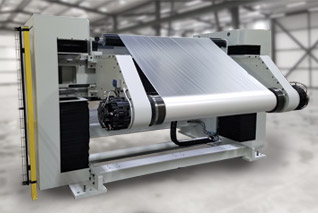by Joe Connelly , Product Manager – Winding and Slitting

Many web processing applications need a way to unwind web material into a subsequent operation. Whether used inline in an extrusion laminating process or offline in a slitting and rewinding operation, an unwind stand must deliver the material into the process while maintaining the proper web tension to ensure reliable web transport. It’s the tension control requirements that can complicate the simple act of unwinding the material.
Why does an unwind need to maintain tension in a web processing operation?
Maintaining tension in the web results in process stability. If the tension goes slack, web traction is compromised resulting in web wander, improper lamination, or wrinkling. Too much tension can also cause wrinkling or can permanently distort or even tear the material. Maintaining the proper web tension at the unwind can be a critical component to the success of a web process.
To control the correct amount of tension, there are two components at play: a braking system that does the physical job of regulating the tension and a tension control system which acts as the command center to signal how much braking to apply. These two systems need to work together, one as the brain and the other as the brawn.
Braking systems commonly used on unwinds come in two variations, mechanical braking and motor generated braking. Each one has advantages and disadvantages but they both provide the vital role of applying torque in proportion to the desired web tension to the shaft or chuck that supports the parent roll.
Mechanical Braking – this type of braking can either be achieved through pneumatic pressure or electrical power, but the concept is similar. They use either air operated brake calipers or electro-magnetic force to generate the correct amount of braking force (or drag). Mechanical brakes are typically the most cost effective to purchase, install, and operate. However, there are wear items, like the brake pads, that need to be replaced from time-to-time. One disadvantage is that sometimes the torque required to accelerate the parent roll exceeds the minimum controllable torque of the mechanical brake. In this case a motor is required to provide assistance.
Motor Driven –when a parent roll must be quickly accelerated to operating speed, the material is very elastic, or the roll is severely out of round, then a motorized unwind should be considered. Since the motor is driving the unwind shaft, it’s able to feed the material into the web processes while maintaining the correct amount of tension. This is especially beneficial when bringing material up to speed in an automatic splicing system or if the material is too delicate to be pulled. When the unwind spindle is being overhauled by the downstream process, the motor regulating torque to the unwind spindle needs to hold the web back and in doing so, regenerates power that must be dissipated somewhere. One big advantage when using today’s more sophisticated AC motor control systems with a driven unwind is the ability to harness this power and feed it back onto the supply buss, which can then redirect this power to pull rolls or winding spindle drives, thus saving on overall power consumption.
Every unwind system is material dependent. The type of material, thickness, speed, width, size of the mill rolls, and how the roll will be used in the web process all need to be considered when engineering an unwind.
In Part 2 of this series, we’ll discuss the types of control systems used to regulate the tension in the braking system.